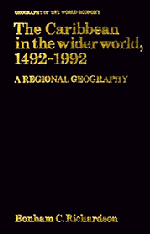Book contents
- Frontmatter
- Contents
- List of maps and tables
- Acknowledgements
- 1 The creation of the Caribbean
- 2 A colonized environment
- 3 Plantations and their peoples to 1900
- 4 The American century
- 5 Economic dependency
- 6 Human migrations
- 7 Resistance and political independence
- 8 Towards a geography of Caribbean nationhood
- Bibliography
- Index
4 - The American century
Published online by Cambridge University Press: 10 November 2010
- Frontmatter
- Contents
- List of maps and tables
- Acknowledgements
- 1 The creation of the Caribbean
- 2 A colonized environment
- 3 Plantations and their peoples to 1900
- 4 The American century
- 5 Economic dependency
- 6 Human migrations
- 7 Resistance and political independence
- 8 Towards a geography of Caribbean nationhood
- Bibliography
- Index
Summary
The Monroe Doctrine, so far as the Caribbean is concerned, is no longer a policy as much in the interest of other American republics as our own. We proclaim the scarcely veiled doctrine of “special interest.” We profess to seek no territory, but we maintain the supreme importance of our own interests in the Caribbean – in a word our hegemony – against everyone else, including the peoples of that region themselves.
Leland Hamilton Jenks, Our Cuban Colony, 1928The interest in the United States expressed by the Cuban slaves of the mid-nineteenth century was reciprocated by the interest that US slaveholders had in Cuba. To some Americans, Manifest Destiny meant moving not only west but also south (May 1973). In 1854 United States President Franklin Pierce authorized an emissary to offer Spain $130 million for Cuba, resulting in the famous Ostend (Belgium) Manifesto that declared the geopolitical inevitability of the US domination of Cuba. Some expansionists went even further, proposing an eventual “golden circle” of US slave states along the Mexican Gulf Coast, Central America, and then north through the Antilles, forming altogether an economic colossus of subtropical agricultural production (McPherson 1988: 103–16).
United States-Caribbean economic ties had, of course, predated US political independence, Yankee traders often penetrating illegally the controlled commerce between European nations and their Caribbean colonies.
- Type
- Chapter
- Information
- The Caribbean in the Wider World, 1492–1992A Regional Geography, pp. 78 - 105Publisher: Cambridge University PressPrint publication year: 1992

